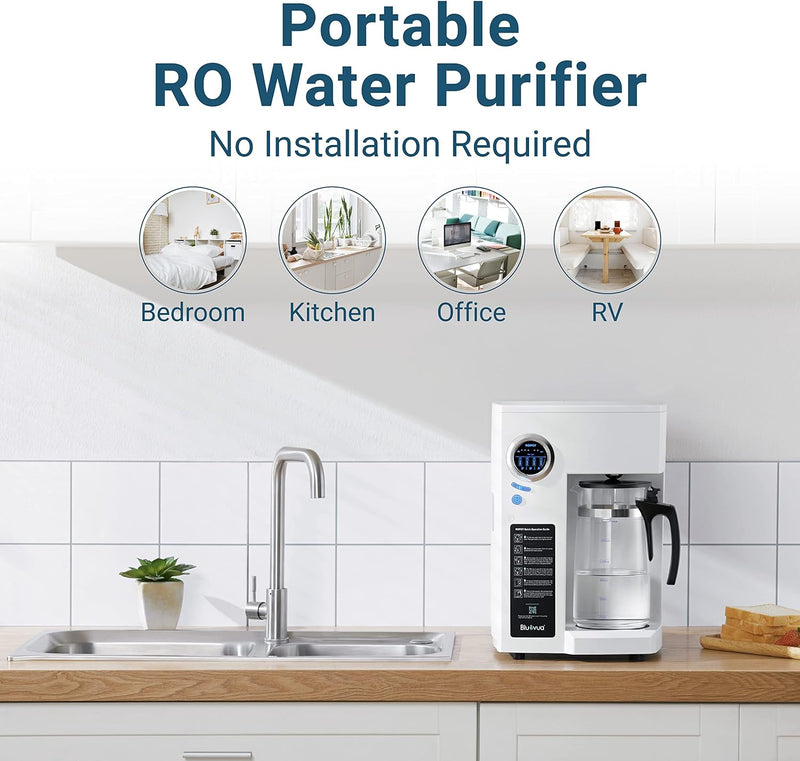Unlock the Secrets of Countertop Reverse Osmosis: The Ultimate Water Filtration Revolution!
In an age where clean drinking water is more essential than ever, countertop reverse osmosis water filters are gaining traction among households looking for effective and convenient solutions. These systems promise not only purified water but also a refreshing taste, free from harmful contaminants. The goal of this article is to demystify how countertop reverse osmosis filters operate, explore their numerous benefits, and compare them to other water filtration options available. As someone who has witnessed the transformation in water quality in a friend's home after installing one of these systems, I can attest to the difference they make in daily life.

Understanding Countertop Reverse Osmosis Water Filters
At the heart of countertop reverse osmosis (RO) systems lies a simple yet powerful principle: osmosis. In nature, osmosis is the movement of water molecules through a semi-permeable membrane from a region of lower solute concentration to one of higher concentration. Reverse osmosis, however, flips this process on its head. By applying pressure, it forces water through the membrane in the opposite direction, effectively filtering out impurities such as salts, heavy metals, and microorganisms. This technology is particularly effective in removing up to 95% of dissolved solids in water, making it a superior choice for purification.
Countertop systems are designed for easy use and setup, typically featuring a compact design that connects directly to your kitchen faucet or sits on the countertop. Unlike traditional filtration methods, which might rely on activated carbon or sediment filters, reverse osmosis systems incorporate multiple filtration stages, including pre-filters and post-filters, to maximize purification. This multi-barrier approach ensures that water is not only clean but also tastes great. My friend Sarah, who struggled with the taste of tap water, found that an RO filter transformed her family's drinking habits, encouraging them to consume more water and stay hydrated.
Benefits of Using Countertop Reverse Osmosis Water Filters
The advantages of countertop reverse osmosis water filters extend far beyond just taste. One of the most significant benefits is the system's ability to eliminate contaminants. This includes chlorine, lead, arsenic, fluoride, and even certain pathogens that can pose health risks. As a result, families can enjoy peace of mind knowing their drinking water is safe. Additionally, many users report that the water produced by RO systems tastes noticeably better than tap water, which can often carry unpleasant odors and flavors due to the presence of chemicals.
Convenience is another key factor. Unlike whole-house systems that require extensive installation and maintenance, countertop models are user-friendly and can be set up quickly. They are ideal for renters or those who may not want to commit to a permanent installation. Over time, the cost-effectiveness of RO systems becomes apparent, as they reduce the need for bottled water and lower the frequency of filter replacements compared to other filtration types. I recall a conversation with my neighbor, who shared that since getting an RO system, they’ve significantly cut down on their spending on bottled water, further contributing to their household budget.
Comparison with Other Water Filtration Systems
When considering water filtration options, countertop reverse osmosis systems stand out in comparison to other common solutions like pitcher filters, faucet-mounted filters, and whole-house systems. Pitcher filters are often the most affordable option but are limited in their ability to remove certain contaminants, requiring frequent replacements and offering smaller volumes of filtered water. Faucet-mounted filters provide convenience but may not deliver the same level of purification as RO systems, which can lead to concerns about water quality.
Whole-house filtration systems, while comprehensive, involve a significant upfront investment and installation requirements. They typically filter water for the entire household, but many people may not require such extensive coverage, especially if they are primarily concerned about drinking water quality. Each system has its pros and cons, but countertop reverse osmosis filters offer a balanced blend of affordability, efficiency, and ease of use that appeals to many homeowners today. A friend of mine who installed a whole-house system later admitted that they often wished they had opted for a countertop model instead, as it would have saved them both money and hassle.
Environmental Impact
Using reverse osmosis systems can also contribute positively to the environment. By reducing reliance on bottled water, households can help minimize plastic waste, which is a significant issue worldwide. Each year, millions of plastic bottles end up in landfills and oceans, contributing to pollution and harming wildlife. By choosing a countertop RO system, families not only ensure their water is clean but also make a small yet impactful change that supports sustainability and environmental preservation.
Choosing a Water Filtration System for a Healthier Future
In summary, countertop reverse osmosis water filters offer an effective and convenient solution for obtaining clean drinking water. Understanding their operation, benefits, and how they compare to other filtration systems can empower consumers to make informed choices about their water quality. With improved taste, enhanced safety, and a positive environmental impact, these systems represent a worthwhile investment for health-conscious individuals and families. As you consider your water filtration options, remember that the choices you make today can lead to a healthier and more sustainable future.








